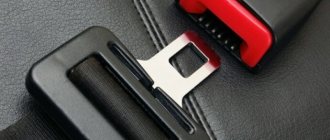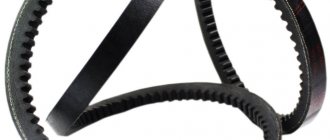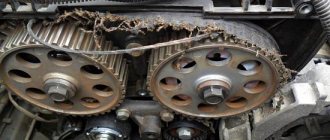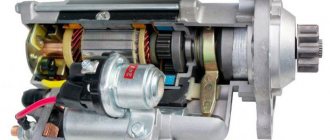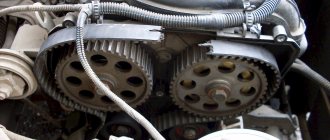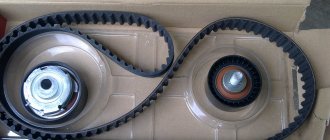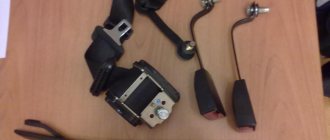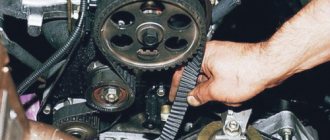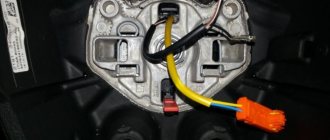It is sometimes believed that the main safety in a car is provided by airbags, however, this is not the case. Airbags help avoid injuries, but only seat belts can save lives. But if no one in their right mind would turn off the airbags, then it is not always possible to force them to use the belts correctly.
To automate the tension, winding (reel) and locking (inertial) mechanisms were introduced into the design. Additionally, emergency tension devices with squibs are installed.
What can cause a seat belt to jam?
The devices included in the coils are quite reliable, but any mechanisms fail over time. This is usually due to wear and tear of parts and contamination.
Coil lock
When braking, as well as a sharp roll of the car body, when an accident or overturn of the car is possible, the direction of the gravity vector changes relative to the body of the belt mechanism. This body itself is rigidly fixed to the body pillar; under normal conditions, its vertical axis coincides with the same axis of the body and the direction towards the ground.
The blocking works on the principle of moving a massive ball, as a result of which the leash associated with it is deflected and blocks the ratchet mechanism of the reel. After returning to its normal position, the coil should unlock.
The second inertia mechanism is an eccentric lever and a gear with an internal tooth on the spool axis. If the unwinding speed exceeds a dangerous threshold, the lever rotates, moves and engages with the tooth. The axis is fixed relative to the body, and rotation is blocked. This does not happen when the belt is pulled out smoothly from the body.
A spiral spring is responsible for retracting the belt into the housing and winding it. It is fully compressed when the belt is extended and relaxes when it is wound up. The force of this spring is enough to press the belt against the passenger with some density.
Wear of mechanism parts
The belt is used with the same regularity as the car as a whole; naturally, the mechanism is subject to wear. Even when moving, the coil continues to partially follow the person’s movements.
On the subject: Why the airbag light is on
Locking mechanisms suffer the most as a result of wear, since they are the most complex part of the structure.
The ball is constantly moving due to changes in terrain, acceleration, braking and cornering. Other elements associated with it also work continuously. The lubricant has the ability to oxidize, dry out and degrade, itself becoming the cause of jamming.
Squibs
Modern belts are equipped with a pretensioning system in case of an accident. At the command of the electronic unit, which has detected abnormal accelerations from the signals of its sensors, the squib in the tensioning mechanism is activated.
Depending on the design, either the released gases under high pressure begin to rotate the rotor of the gas engine, or a set of metal balls moves, causing the coil axis to twist. The belt takes up as much slack as possible and presses the passenger tightly to the seat.
After operation, the mechanism will inevitably become jammed and the belt will no longer be able to unwind or rewind. According to safety regulations, its further use is unacceptable; the textile is cut and replaced complete with the body and all mechanisms. Even if it is repaired, it will no longer be able to provide the required level of security.
Coil problem
The coil usually stops working normally for several reasons:
- fraying of the textile material itself after long use;
- dirt getting into rotation units;
- corrosion and wear of parts;
- weakening of the spiral spring after being in a twisted state for a long time when using all kinds of clothespins, which is strictly not recommended.
The spring can be tightened by increasing its preload. This is a difficult task and requires extreme care, since after removing the plastic cover the spring will immediately unwind and it will be extremely difficult to return it to its place, much less adjust it correctly.
FAQ
Is it necessary to use a seat belt?
Yes, by law. Otherwise, you face a fine of 1000 rubles.
How many drivers actually use seat belts?
Despite what was said earlier, according to statistics, slightly less than half. But it is not recommended to risk your health and have the possibility of getting a fine.
What is the price for repair or restoration?
Small. Rarely more than a few hundred, at most thousands of rubles.
How to find the cause of the problem
After removing the reel housing from the stand, you must position it strictly vertically and try to smoothly pull the belt out of the housing. If there is no tilt, the belt should come out easily and when released, retract back.
If you tilt the body, the ball will move and the reel will be blocked. A working mechanism restores its operation after returning to a vertical position. Wedging indicates a malfunction of the ball lock.
This is interesting: Where is the safest place in the car for a child?
If you pull the belt fast enough, the centrifugal lock with the eccentric lever will work, and the reel will also be locked. After release, the work is restored and there should be no interference with smooth pulling.
Work on diagnosing the pyrotechnic tensioner is only available to specialists due to the danger of the mechanism. There is no need to try to test it with a multimeter or disassemble it.
Effect of frost
Sometimes the seat belt latch may not work due to extreme cold. This will not require changing any parts. In some older vehicles, the insulation of the mechanism may not be sufficient. This causes the belt to jam.
In this case, the oil that lubricates the system becomes thicker in the cold. You will have to disassemble the coil and lubricate its elements with a special substance. It must be frost resistant. This, for example, could be silicone grease or lithol.
Seat belt repair
Available repair methods include partial disassembly of the mechanisms, cleaning, washing, drying and lubrication.
Tools
Not in all cases, repairs can be made using standard tools. Sometimes the internal fasteners contain non-standard screw heads, making it difficult to purchase the corresponding keys.
But in most cases you will need:
- a set of keys for removing housings from the body;
- slotted and Phillips screwdrivers, possibly with replaceable Torx-type bits;
- a clip for fixing an extended belt;
- a can of aerosol cleaner;
- universal grease, preferably silicone-based.
The procedure depends greatly on the specific car model and belt manufacturer, but there are some general points.
Instructions
- The belts are removed from the body. To do this, you will need to unscrew several bolts from the body nuts using socket or socket wrenches.
- Use a thin screwdriver to press out the fasteners, unscrew the screws and remove the plastic covers. Unless necessary, do not touch the cover under which the spiral spring is located.
- The ball body is removed, the parts are cleaned and inspected, and if spare parts are available, worn or broken ones are replaced.
- The mechanism is washed with a cleaner, dirt and old grease are removed. A small amount of fresh lubricant is placed in the friction zones. You can’t have too much; too much will interfere with the free movement of parts.
- If you need to disassemble the inertia mechanism and spring, remove the cover after removing the fasteners with extreme caution. The levers of the mechanism must move freely and jamming is not allowed. To increase the tension of the spring, its inner tip is removed, the spiral is twisted and fixed in the new position.
- The parts should be washed with cleaner and lightly lubricated.
The best solution would be not to try to repair the belt, especially if it has been in use for a long time, but to replace the entire assembly with a new one.
Over time, the reliability of operation decreases, and the likelihood of successful repair is also low. Finding new parts is almost impossible, and used ones are no better than existing ones. Saving on safety is always inappropriate, especially when it comes to belts.
Their material itself ages quickly and in case of danger, all this will work abnormally, which will lead to injuries. No airbags will help if the belts fail; on the contrary, they can become an additional danger.
Diagnostic methods
Let's look at the procedure and methods for checking the condition of seat belts. For example, let's look at how to carry out diagnostics on a Ford Focus car.
Insufficient belt retraction
If the belt does not retract well, check how the decorative covers are installed to make sure they are not touching the belt tape. Also check to see if the belt is rubbing against the retractor. If this is the case, then loosen the fastening bolt and align the device so that the tape is in the middle.
Most cars have 2 front and 3 rear retractable seat belts. They are equipped with double protection by sensitive elements.
- Vehicle motion sensor – blocks the belt during braking, sharp turns, descents, and ascents.
- Belt movement sensor – blocks it when pulled sharply.
These systems must function properly. To check them, special control methods are used.
How to check a car motion sensor
There are two ways to test this sensor.
First way
This will require the participation of two people. The first way is to slow down. During the inspection, people in the vehicle must not interfere with the operation of the seat belts.
- Choose a flat section of road with good visibility.
- The driver must sit in a comfortable position with the seat belt fastened and correctly adjusted.
- Drive no faster than 10 km per hour.
- Brake sharply to stop the car. If the locking is working properly, the belt will lock.
- The check is performed twice for the front and rear seats.
A belt retractor device that is not capable of restraining a person must not be used.
Second way
To do this, you need a flat road with a circular motion so that the car's steering wheel is in the extreme position.
- The driver is wearing a seat belt.
- The passenger sits in the back seat and also buckles up.
- Start the engine, turn the steering wheel all the way to the left and drive at a speed of 16 km per hour.
- When the passenger tries to slowly pull out the belt, it should lock.
If any of the belts can be pulled out, then they cannot be used.
How to check the elements of the locking mechanism
The car must be stationary on a horizontal, level road. Grab the seat belt and try to pull it sharply. The lock should engage after 25 cm of extension. Otherwise, such a belt must not be used. Such a simple check allows diagnostics to identify faults and replace worn belts with new ones.
see also
Comments 29
I had the same problem with the belts on my Octavia. They came off very poorly. So I sold them with this problem. But the new owner replaced them anyway. After my accident, they worked!
The problem is solved with the help of silicone grease in cans. Pull out the belt completely, spray generously on both sides, and so on two or three times. Tested on more than one machine.
if the belts have fired squibs, then this may be the reason, but if there is no squib, or did not fire, then the dirt makes the belt less flexible and the installation works worse.
The problem could be:
In the spring
The reason is the freezing of the lubricant at sub-zero temperatures along with ordinary aging of the lubricant. Disassemble the casing and remove the block that winds up. Clean, remove old grease and lubricate with anti-freeze grease. Litol, CV joint, fiol and other greases thicken in the cold. Here you need a frost-resistant lubricant, for example Ciatim201 or its equivalent. Alternatively, liquid silicone.
In the belt itself
It helps to wash the belt itself with soap or powder. It gets dirty and becomes stiff - as a result, it doesn’t wind up well. Pull out, stop, carefully wash and dry.
PS
You do all work at your own peril and risk. Disconnect the battery terminal so that the squib does not fire during all these operations and there is no error message.
PS 2.
Before disassembling, you can pull out the belts all the way and look - maybe they just overlap on the reel.
PS 3.
If you disassemble the coil itself, look for a report somewhere as there are nuances there. Easy to disassemble, difficult to assemble.
This is a detailed answer, thank you very much.
I came across this problem. I know how stressful it is. I wish you a speedy solution.
As I understand it, I need to do the same with my problem?)
As I understand it, I need to do the same with my problem?)
Well, yes, there are the usual mechanics. Either the belt is hard or there is grease. All because of dust/dirt.
It's clear. Well, I'll break it at the ends. THX!)
The problem could be:
In the spring
The reason is the freezing of the lubricant at sub-zero temperatures along with ordinary aging of the lubricant. Disassemble the casing and remove the block that winds up. Clean, remove old grease and lubricate with anti-freeze grease. Litol, CV joint, fiol and other greases thicken in the cold. Here you need a frost-resistant lubricant, for example Ciatim201 or its equivalent. Alternatively, liquid silicone.
In the belt itself
It helps to wash the belt itself with soap or powder. It gets dirty and becomes stiff - as a result, it doesn’t wind up well. Pull out, stop, carefully wash and dry.
PS
You do all work at your own peril and risk. Disconnect the battery terminal so that the squib does not fire during all these operations and there is no error message.
PS 2.
Before disassembling, you can pull out the belts all the way and look - maybe they just overlap on the reel.
PS 3.
If you disassemble the coil itself, look for a report somewhere as there are nuances there. Easy to disassemble, difficult to assemble.
and if it gets stuck specifically in the loop, what’s on the stand? I removed the cover in the cabin from the rack, it runs fine until the hinge, but after that it slows down
